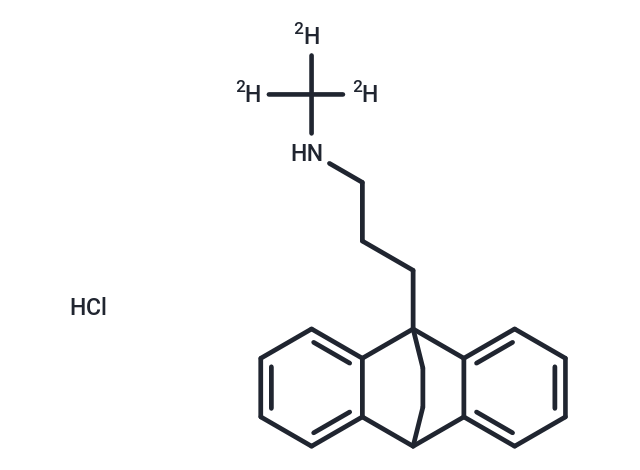 您的购物车当前为空
您的购物车当前为空
Maprotiline-d3 hydrochloride
一键复制产品信息Maprotiline-d3 is intended for use as an internal standard for the quantification of maprotiline by GC- or LC-MS. Maprotiline is a tricyclic antidepressant. It binds to the norepinephrine transporter (NET) and is selective for NET over the serotonin and dopamine transporters. Maprotiline also binds to the serotonin (5-HT) receptor subtype 5-HT2A, as well as histamine H1, muscarinic acetylcholine, α1-adrenergic, and dopamine D2 receptors. In vivo, maprotiline inhibits norepinephrine reuptake in rat brain and peripheral tissues. It reduces isolation-induced aggressive behavior and inhibits electrical foot-shock stimulation-induced belligerence in mice when administered at doses ranging from 3 to 10 mg/kg. Maprotiline also reduces aggressive behavior in rhesus monkeys housed in groups. Formulations containing maprotiline have been used in the treatment of depression and anxiety.

Maprotiline-d3 hydrochloride
一键复制产品信息Maprotiline-d3 is intended for use as an internal standard for the quantification of maprotiline by GC- or LC-MS. Maprotiline is a tricyclic antidepressant. It binds to the norepinephrine transporter (NET) and is selective for NET over the serotonin and dopamine transporters. Maprotiline also binds to the serotonin (5-HT) receptor subtype 5-HT2A, as well as histamine H1, muscarinic acetylcholine, α1-adrenergic, and dopamine D2 receptors. In vivo, maprotiline inhibits norepinephrine reuptake in rat brain and peripheral tissues. It reduces isolation-induced aggressive behavior and inhibits electrical foot-shock stimulation-induced belligerence in mice when administered at doses ranging from 3 to 10 mg/kg. Maprotiline also reduces aggressive behavior in rhesus monkeys housed in groups. Formulations containing maprotiline have been used in the treatment of depression and anxiety.
| 规格 | 价格 | 库存 | 数量 |
|---|---|---|---|
| 1 mg | ¥ 3,520 | 35日内发货 | |
| 5 mg | ¥ 7,330 | 5日内发货 | |
| 10 mg | ¥ 9,880 | 5日内发货 |
Maprotiline-d3 hydrochloride 相关产品
产品介绍
| 产品描述 | Maprotiline-d3 is intended for use as an internal standard for the quantification of maprotiline by GC- or LC-MS. Maprotiline is a tricyclic antidepressant. It binds to the norepinephrine transporter (NET) and is selective for NET over the serotonin and dopamine transporters. Maprotiline also binds to the serotonin (5-HT) receptor subtype 5-HT2A, as well as histamine H1, muscarinic acetylcholine, α1-adrenergic, and dopamine D2 receptors. In vivo, maprotiline inhibits norepinephrine reuptake in rat brain and peripheral tissues. It reduces isolation-induced aggressive behavior and inhibits electrical foot-shock stimulation-induced belligerence in mice when administered at doses ranging from 3 to 10 mg/kg. Maprotiline also reduces aggressive behavior in rhesus monkeys housed in groups. Formulations containing maprotiline have been used in the treatment of depression and anxiety. |
| 分子量 | 316.8873 |
| 分子式 | C20H21D3ClN |
| CAS No. | 1329496-63-0 |
| 存储 | Powder: -20°C for 3 years | In solvent: -80°C for 1 year | Shipping with blue ice/Shipping at ambient temperature. |





 还可以
还可以

 |
|
评论内容